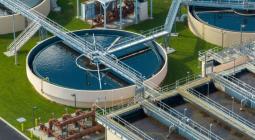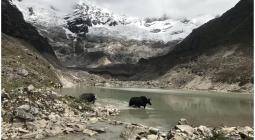Puddle Britain: 11 amazing facts about tiny bodies of water

Whether it’s too much rain or not enough drainage, we’re deep into November and there’s water everywhere. So, what is a puddle, when does it become a pond – and what lives in there?
Thanks to a combination of ceaseless rain and poor drainage – or, if you like, the climate crisis and broken Britain – puddles are everywhere. You encounter them at every corner on your way to work, at every gate on a country walk, any time you try to drive through a poorly maintained underpass. But what do we really know about puddles? Here are the answers to 11 questions you probably never thought to ask, starting with the most basic.
What is a puddle?
While we tend to know one when we see one, a solid definition for this small body of water is hard to arrive at, even for experts. “A puddle is just what you imagine, really – it’s something that’s shallow enough to splash in,” says Prof Jeremy Biggs, the CEO of the Freshwater Habitats Trust. “It will almost inevitably be rain-filled; it won’t be filled by a pipe or an inlet or something like that. And it dries up pretty quickly, in hours, days or weeks.”
Although puddles don’t last long, they do persist over years. “You think they’re ephemeral and come and go, but they will tend to form in the same place, because they form where there are depressions,” says Biggs.
When does a puddle become a pond? Or, for that matter, a lake?
Biggs is also the author of the book Ponds, Pools and Puddles, so he is the man to answer this question. There are no hard and fast differences, he says, but because people keep asking, the trust has created some guidelines based on size. “In the UK, we call everything up to 2 hectares [about 5 acres] a pond, but a lake that’s 2.1 hectares is really no different from a pond that’s 1.9 hectares,” he says. “Down the bottom end, we call things down to 1 sq metre a pond, so then it’s below that we have puddles.”
There is also a distinction to be made between puddles and temporary ponds. To qualify for the second category, the pond must be wet for at least four months of the year (although I think we have all known puddles of that duration).
When does a puddle become a problem?
If it’s in the road, it gets to be a problem once it reaches a certain depth, after which it becomes tricky to drive through. These days, cars have reliably watertight door seals, but this also makes them buoyant. Some cars will float in just 15cm of water; most will float in 60cm. How deep you can go will depend on the clearance of your vehicle, but as a general rule you shouldn’t drive through water – especially fast-moving water – that is more than 10cm deep.
Is it illegal to drive through a big puddle?
The short answer is: sometimes. “Any driver who deliberately or inadvertently splashes a pedestrian when going through a puddle risks penalty points on their licence and a fine,” says Simon Williams, the head of PR at the RAC.
Under section three of the Road Traffic Act 1988, splashing pedestrians can be classed as driving without reasonable consideration for other persons. “As of 2013, inconsiderate driving can be dealt with by a fixed-penalty notice with a £100 fine and three penalty points,” says Williams. “If a driver refuses to pay the fixed-penalty notice, then they could be taken to court, where a magistrate could impose a fine up to £5,000, although the maximum is unlikely.”
If I have to drive through a puddle, what should I do?
Get out and gauge the depth, then check for any obstacles under the water. Keep to the centre of the road, which is generally the highest point. “Keep your vehicle in a low gear (second is generally adequate) and engine revs up,” advises the RAC’s website. “This will help you maintain momentum when you travel through the puddle, creating a bow wave so you don’t get bogged down.” It is also advisable to test your brakes on the other side, as the water can temporarily affect their performance.
Does a pothole full of water count as a puddle?
It probably started life as a puddle. As standing water finds cracks in the road surface, it washes away the subsoil beneath. Cars driving over this weak spot will create a crater, which, if left untreated, will expand.
The biggest problem with a rain-filled pothole is that you can’t tell how deep it is. A puddle can even hide the fact that a pothole lurks beneath, risking serious damage to your vehicle.
Can anything live in a puddle?
Despite their temporary nature, puddles are often thriving and important ecosystems. “There’s a group of really special, uncommon, protected, rare, endangered water plants that need that kind of puddly habitat,” says Biggs. Among them are pillwort, tassel stonewort, three-lobed crowfoot and lesser water plantain.
Can animals survive in puddles?
“Once a puddle has got to about 6in [15cm] deep, and is there for more than a couple of months, almost everything that you can think of as living in freshwater can, except for big fish,” says Biggs. Common puddle residents include beetles, water snails, newts and even tadpoles.
What is Britain’s most famous puddle?
The notoriety they attract tends to be as fleeting as the puddles themselves. Who, for example, remembers the legendary Drummond puddle, which captivated the country for a sizeable fraction of 6 January 2016?
It was just an ordinary, large puddle at one end of a pedestrian bridge in Newcastle – until some workers at a nearby marketing agency, called Drummond Central, started livestreaming as cyclists and commuters tried to cross it. Over the six hours of its existence, more than 500,000 people joined #DrummondPuddleWatch. As the puddle’s fame grew, people took selfies in front of it, some equipped with lilos and surfboards. A bottle of Drummond puddle water turned up for sale on eBay. Local news picked up the story. National newspapers followed suit.
The next day, the council cleared a drain, the puddle disappeared and its fame evaporated. Even Periscope, the streaming service that brought the puddle to global attention, was discontinued in 2021.
What is Britain’s biggest puddle?
This is difficult to measure; do we use length, depth, area or volume? With no governing body to verify the title, the distinction is awarded unofficially dozens of times a year by headline writers.
Some notable recent contenders include the 100-metre-long puddle of Whaddon Road in Cheltenham, the pothole “lake” of Osgodby in Lincolnshire and the chair bridge puddle of Hammersmith in west London, so called because a row of armchairs (well, four) was lined up to enable commuters to cross the street.
Are there any places in Britain named after puddles?
Yes, but not very many – and the most obvious examples are misleading. Puddletown in Dorset was named after the River Piddle (which runs through it) and was formerly called Piddletown, to the general mortification of residents. Also inspired by the Piddle are Tolpuddle, just downstream, Affpuddle, Turners Puddle and Briantspuddle.
There is also a short street called Puddle Dock, near the Thames at Blackfriars in central London, which commemorates a wharf that became better known in the 19th century as a sewer outfall – a piddle dock, really. Anyway, you won’t find anything there today. Except maybe a puddle.
Photograph: Bonfanti Diego/Getty Images/Image Source





